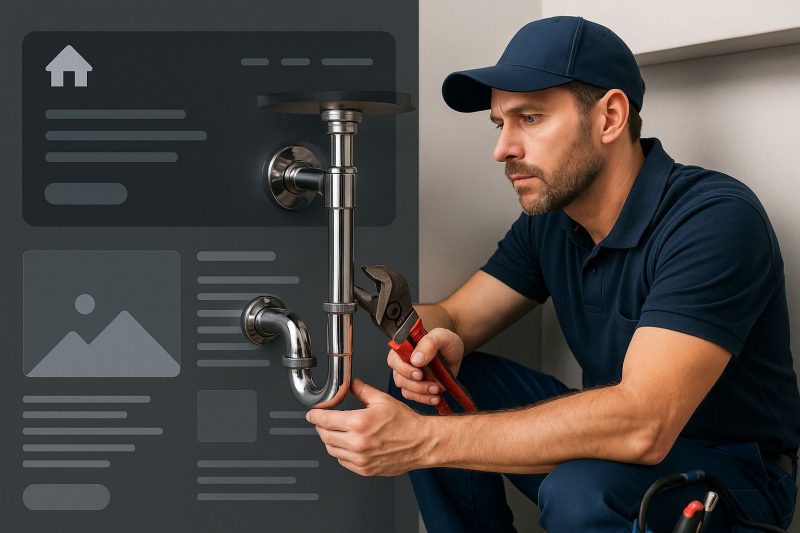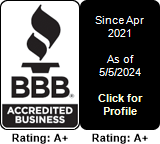In Macon, Georgia, plumbing is more than a trade; it’s an essential, reputation-driven business where trust, speed, and local visibility make the difference between a booked job and a missed opportunity. For many plumbers serving neighborhoods like Shirley Hills, Vineville, or North Macon, customer acquisition still leans on word-of-mouth and local directories. But in 2025, a growing number of those word-of-mouth referrals come from Google searches, not front porch conversations. The question isn’t whether homeowners search online; it’s whether your website earns their click, holds their attention, and drives them to call. A clean logo and a phone number are no longer enough. If your plumbing site in Macon isn’t designed to convert, it’s leaking more leads than you realize. This guide breaks down the design strategies that help local plumbers turn urgent web visits into scheduled repairs and grow with confidence in a competitive digital landscape.
Prioritize Speed and Mobile UX in Emergency-Driven Markets
When someone searches “emergency plumber Macon,” they aren’t browsing; they’re in distress. Maybe a pipe burst in Payne City. Maybe the water heater died in the middle of a North Macon winter. Either way, that visitor expects your site to load fast, explain clearly, and offer a clear next step. If your homepage stutters or your tap-to-call button is buried, you’ve already lost them. Mobile-first design in plumbing isn’t about layout aesthetics; it’s about urgency. Every second your site delays, every form that feels clunky, and every CTA that disappears on scroll silently tells the customer to keep searching. Use compressed imagery, simple navigation, sticky call buttons, and fast hosting built for mobile-first responsiveness. And always, always test your core funnel: homepage to call or form on real devices.
-
Optimize image sizes to reduce mobile load times under 3 seconds
-
Place a fixed “Call Now” bar at the bottom of the mobile viewport
-
Eliminate pop-ups or overlays that block fast interaction
Anchor Trust with Real Photos and Local Proof
Macon residents are fiercely local, and it shows in how they choose service providers. They don’t want a national brand’s website clone. They want to know who’s going to show up at their door. Stock photography, generic service pages, and vague promises erode trust. Replace generic pipe images with photos of your actual team. Show your van outside recognizable landmarks: downtown brick buildings, local neighborhoods, a branded truck parked off Riverside Drive. Highlight testimonials from local clients and use city-specific copy like “serving homes in North Highland and East Macon.” That regional language, paired with real visual proof, creates immediate emotional trust that out-of-town competitors can’t replicate.
-
Showcase staff photos in real service environments
-
Use quotes from verified customers in Macon neighborhoods
-
Include visual proof of licenses, trucks, or uniforms
Structure Service Pages Around Search Intent
Most plumbing websites lump everything: leaks, water heaters, pipe repair into one page. But users don’t search that way. They Google “sewer line repair Macon” or “water heater replacement near me.” If your site offers one generic “Services” page, Google has no reason to rank you for specific, high-intent searches. Instead, create individual pages for each major service category: leak detection, drain cleaning, pipe repair, water heater installation, and emergency response. Include headings that match how people search. Use phrases like “Same-day drain unclogging in Macon” or “Gas line repair for Middle Georgia homes.” Structure each page with a clear intro, scannable bullet points, neighborhood-specific details, and a strong call-to-action.
-
Match page URLs and H1s to common service-related queries
-
Use FAQ sections to expand semantic relevance
-
Add location references within the service descriptions
Use Sticky CTAs That Don’t Interrupt the Scroll
Most plumbing websites still rely on one “Contact Us” button at the top or bottom. But in a field where urgency is everything, CTAs need to stay visible throughout the visit. A sticky “Call Now” bar that follows the user on mobile is far more effective than asking someone to scroll back to the top. Use contrast wisely; bright CTAs on a clean background work best. Pair buttons with reassuring microcopy like “Licensed | Insured | Fast Response.” And for users not ready to call, include a simplified form: name, zip code, brief issue. Remove friction and you reduce hesitation.
-
Include two or more CTA entry points per page for redundancy
-
Use mobile-friendly buttons sized for thumb tapping
-
Repeat critical CTAs after each key content section
Visual Hierarchy That Reflects How People Scan for Help
Homeowners don’t read plumbing websites; they scan. Especially on mobile, they’re hunting for the answer to one question: “Can you fix this now?” Your design should reflect that. Use large, bold service headlines (“Water Heater Out?”), short paragraphs, and icons that segment services visually. Put your license number, service hours, and coverage area high on the page. If you offer 24/7 emergency service, make sure that message is the first thing someone sees on mobile, not a bio paragraph or mission statement. Trust follows clarity, and clarity starts with structure.
-
Design content blocks in vertical stacking format
-
Use icons and whitespace to separate key service areas
-
Keep the font hierarchy consistent across all pages
Embed Local SEO Into the Page, Not Just the Backend
Ranking well in Macon doesn’t just happen in metadata. It starts with how your design supports location intent. Instead of saying “We offer plumbing services,” say “We provide fast plumbing repairs to homes across Macon, including Vineville, East Macon, and Lake Wildwood.” Embed Google Maps with your address. Use FAQ blocks that answer real local search queries like “Do you serve Warner Robins?” or “What are your after-hours rates in Bibb County?” Design supports SEO when it turns keywords into visible, trustworthy signals. When Google sees your business speaking the language of place, you rise above generic competitors.
-
Use semantic headings that include neighborhood references
-
Embed your Google Business Profile map on key pages
-
Add localized testimonials with area names mentioned
Shorten the Funnel: Every Page Is a Conversion Point
In plumbing, every page is a potential entry point. A visitor might land directly on your “Toilet Repair Macon” page from search, not the homepage. So treat every page like it’s the only one they’ll see. Include a clear value prop, local cues, and CTA on each service page. Remove unnecessary distractions like image sliders, redundant testimonials, or social widgets that pull users away. Funnel logic isn’t just for homepages; it’s for every URL that gets traffic. Every entry point should guide a worried user toward action.
-
Ensure all service pages have one clear primary CTA
-
Remove elements that lead users off-site too early
-
Reinforce next steps with clear action-oriented button text
Highlight Service Areas With Confidence and Clarity
A lot of local plumbers in Macon serve multiple zip codes but hide that info deep inside footers or about pages. Flip that. Create a section or dedicated page titled “Where We Work.” List specific neighborhoods, zip codes, and even landmarks: “We serve downtown Macon, Westside, Avondale Mill Village, Payne, and anywhere within 30 miles.” This not only helps search rankings, but it reassures customers that you’re nearby and available. You can even add short content blocks per area with testimonials or photos, building topical relevance and local trust.
-
List zip codes and neighborhood names in bullet form
-
Include area-specific success stories or quotes
-
Add internal links from each zone name to related services
Let Your Forms Feel Like Conversations, Not Contracts
Many plumbing forms are clunky and off-putting. “Describe Your Plumbing Issue in Detail” feels like homework. Instead, break forms into conversational steps: “What seems to be the issue?” “What time works best for you?” Keep fields minimal and auto-fill where possible. Use friendly microcopy like “We’ll call you within 15 minutes.” And always show progress (Step 1 of 2). Forms that feel human generate more completions, and in plumbing, every form completion is a qualified lead.
-
Reduce required fields to only name, contact, and issue
-
Use step-based layout to avoid overwhelming the user
-
Pre-fill subjects based on the page where the form appears
Use Trust Seals and Real-Time Response Promises
Trust can’t be faked, but it can be signaled. Include certification seals (licensed, bonded, insured), BBB logos if applicable, and Google rating snippets. Even a simple badge that says “5-Star Google Reviews in Macon” can sway uncertain users. Reinforce your commitment to fast response: “Average Response Time: Under 1 Hour” builds urgency and shows readiness. If you answer phones live, say so. And if you offer text-based contact, make it a visible option, especially for users who can’t call during work hours.
-
Display licensing and certification logos near CTAs
-
Add trust-focused badges that verify response times
-
Show review ratings with sources like Google or Yelp
Conclusion: Plumbing Leads Start With Smarter Design
If your plumbing business in Macon is relying on referrals and old templates, you’re losing leads to competitors with sharper digital foundations. But this isn’t about gimmicks or trends. It’s about understanding what local users want when they need urgent help and giving it to them fast, clearly, and confidently. With mobile-first structure, trust-driven visuals, localized language, and conversion-oriented UX, your website can stop being a static brochure and start becoming your strongest lead generator. For Macon plumbers ready to grow without chasing every call manually, smart design is the first fix worth making.
-
Shift focus from visual flair to structured utility and response
-
Treat your website as a lead engine, not a branding formality
-
Invest in clarity, speed, and localized signals to stay ahead in Macon
Looking for a web design firm in Macon that understands how local businesses grow online? At Southern Digital Consulting, we don’t just build beautiful websites. We engineer digital experiences that turn visitors into leads. Whether you run a service business on Riverside Drive or a boutique shop near downtown, your website is the first impression customers trust. That’s why every design we create is structured for clarity, speed, and conversion. It’s built locally and optimized for real results in Middle Georgia.
Q1: Do Macon homeowners care about seeing a plumber’s location on the website?
Yes. In neighborhoods like Vineville or East Macon, people want to know you’re nearby. Showing your service area clearly builds trust and gets you more local calls.
Q2: How important is mobile-friendly design for plumbing sites in Macon?
Very. Most emergency searches in Macon happen from mobile phones. If your site isn’t fast and easy to use on a phone, you’ll lose leads in seconds.
Q3: What makes plumbing customers in Macon trust a website faster?
Real photos, local reviews, and simple language matter most. People in Macon want to see who they’re hiring, not stock images or corporate jargon.
Q4: Should plumbers in Macon create separate pages for each service?
Yes. A page for water heater repair in North Macon will rank better and convert more than a generic services list. Local search favors specificity.
Q5: Do customers in Macon use online forms or prefer to call?
Both. Older clients often call, but younger homeowners fill out short forms—especially if they’re at work. Having both options wins more jobs.


